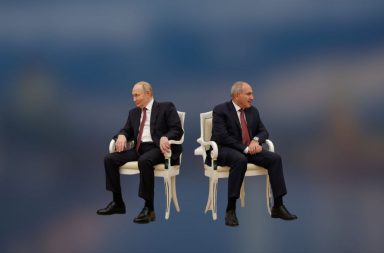By Gevorg Ghukasyan, PhD in Political Sciences
Special Project Manager at Armenian National Committee – International
The events in Washington on August 8, 2025 have sent shockwaves through Armenia’s sociopolitical life. The memorandum signed by the heads of Armenia and Azerbaijan in the presence of the U.S. President, the parallel bilateral memoranda concluded between the U.S. and the two South Caucasus states, and the peace and interstate relations agreement preliminarily mediated by Washington—alongside other agreements under the banner of the “Trump Path to International Peace and Prosperity”—seek to substantially reconfigure the logic of political processes and the levers of international influence in the South Caucasus.
The agreements touch upon the most delicate, sensitive, and high‑risk elements of Armenia’s security architecture. Contrary to the unwarranted enthusiasm demonstrated by Armenian authorities, these agreements—borne of considerable concessions by Yerevan—have ushered in a new cycle of uncertainty. Yet, the probability that political dynamics in the South Caucasus will no longer follow their previous course is quite high. This likelihood is further magnified by the fact that the principal drivers of geopolitical influence in the region have undergone deep transformation.
Geopolitical Subtext
It has long been assumed that geopolitical interests and developments in the South Caucasus were conditioned by three primary factors:
- The unresolved ethno‑political conflicts (Nagorno-Karabakh, Abkhazia, and South Ossetia).
- The Caspian energy players and the infrastructure for their extraction and transit.
- Post‑Soviet transformation, and Western strategies to limit Russian influence through soft power and indirect instruments.
For nearly three decades, these were the pillars shaping the geopolitical logic of the region. The turning point came with the 2020 Karabakh war, the ceasefire declaration of November 9, the consolidation of Russian presence in Armenia and Artsakh, the onset of the Russia–Ukraine war in February 2022, the occupation of Armenian territories, the stationing of an EU observation mission in Armenia, and the ethnic cleansing in Artsakh. Together, these events overturned nearly everything in the South Caucasus: borders, demographics, spheres of influence, and more. Added to this were developments in Georgia and the Iran–Israel confrontation—along with direct American involvement. Altogether, these changes created a power vacuum in the South Caucasus. Historically, such vacuums rarely endure in international relations.
At its core, international affairs still rest on fundamentals often traced back to the Peace of Westphalia: balance of power, counterbalancing mechanisms, and the interplay among actors. These ideas, while rooted in European political thought, continue to manifest globally, regionally, even locally. In recent years, developments in the South Caucasus have undermined these very principles. Russia’s influence and engagement in the region have weakened; the Iran–Israel conflict has called into question Iran’s capacity to expand influence as a regional counterbalance; and Turkey’s role as Azerbaijan’s principal ally has rapidly grown. As Ankara shares in the spoils of victory with Baku, it exerts significant influence over both Azerbaijani and Armenian leadership. Given Turkey’s long‑term strategic goals—including pan‑Turkic initiatives and expanding influence in Asia—its emergence as a dominant regional player poses a challenge to any counterforce. In this environment, the United States is seeking a more concrete entry into the region—not as a distant actor, but as an agent reshaping dynamics on the ground.
It is noteworthy that Turkey, while a longtime key U.S. ally and a NATO member, has always presented a paradox for U.S. regional strategy: a powerful partner that must nonetheless remain subject to American control or management. This issue was addressed in a prior ARFD commentary, “American Mace, Turkish Nightmare, and Armenian Expectation.” The point here is not to portray Turkey as merely a U.S. proxy, but to emphasize the American objective of keeping Turkey controllable and governable.
Thus, from a world‑order perspective, in a region where the balance of power and counterbalancing have been fundamentally disrupted, it is neither surprising nor illogical that the United States would pursue a more assertive presence.
In this context, it is relevant to recall Henry Kissinger’s insight in Diplomacy, where he argues that the ambitions of more aggressive actors are kept in check by the combination of other international players—thus preserving equilibrium in world affairs.
Beyond that, current dynamics in the South Caucasus are influenced by the reconfiguration of global transit routes. Various initiatives linking Central and Southeast Asia with Europe gained added importance in the aftermath of the Russia–Ukraine war, which disrupted traditional corridors. In particular, the West seeks alternatives that diminish China’s economic influence.
Macro & Micro Processes
Geopolitics is not all there is, even if it sets the broader frame. Macro geopolitical processes create the structural conditions in which states operate; within that frame, smaller states act at the micro level—sometimes successfully defending national interests, sometimes failing. In Armenia’s case, the authorities have repeatedly failed to harness these micro-level dynamics effectively. That is, while the geopolitical structure does not predetermine everything, it does delimit the range of possibilities.
Occasionally, regional shocks or strategic shifts offer smaller states opportunity windows—moments to advance national interest. Indeed, Armenia accomplished this toward the end of the Soviet era; Azerbaijan has maneuvered similarly in recent years.
Baku’s Priorities
Returning now to the Washington agreements: to properly assess their impact on Armenia, one must first understand the political priorities that guide Baku and Yerevan in this process.
Following the ethnic cleansing in Artsakh, Azerbaijan has pursued a range of short‑ and long-term, tactical and strategic priorities. On the tactical side, its negotiation table demands included: securing unobstructed land access via Armenian territory to Nakhichevan; declaring the Karabakh issue closed; dissolving the OSCE Minsk Group; withdrawing Armenian claims in international courts; modifying Armenia’s constitution, etc. On its U.S. relations front, Baku sought to repair its relations with Washington, which had soured earlier in 2023, reverse U.S. House Resolution 907, and obtain American political, military, and other support.
The Washington accords have effectively delivered on nearly all these priorities—except for constitutional reform in Armenia, which is not directly addressed in these accords, though it features in Armenian political rhetoric. Another Baku demand—the withdrawal of Armenian legal claims in international courts—had already been acquiesced by Yerevan months earlier and is embedded in the peace agreement’s text.
Yerevan’s Priorities
Regrettably, the political priority of Armenia’s authorities in recent months has been little more than signing a document—regardless of legal substance or consequences. They have reached that goal. Yet this was never a priority ordained by Armenia’s national or state interest, but rather a political imperative of the ruling class aimed at ensuring its continuation in power. Within this framework, the authorities agreed to unhindered land connectivity, the dissolution of the Minsk Group, closure of the Karabakh issue, prohibition on third‑party force deployment along Armenia’s borders, suppression of “revanchism” or “revenge,” renunciation of legal claims in international courts, and more.
Objective Issues and Concerns
From an objective standpoint, the newly signed memoranda and the preliminarily negotiated agreement raise more questions than certainties. Among the most pressing concerns:
- The agreements sidestep fundamental conditions of genuine peace, including:
- The right of return for Artsakh’s Armenian population
- Unconditional release of Armenian prisoners of war and detainees
- Withdrawal of Azerbaijani armed forces from occupied Armenian territories
- A legally grounded basis for border delimitation and demarcation
- Guarantees for the rights and security of displaced Artsakh Armenians
- The status or protection mechanisms for Armenian-populated areas
- The accords do not stipulate effective implementation, monitoring, or guarantee instruments.
- The agreements, in effect, impose limitations on international law—especially via clauses on withdrawal of legal claims.
- No alternative international mechanism is proposed to replace the dissolved OSCE Minsk Group in addressing unresolved issues within a framework of mutual confidence.
- The Armenian authorities lack the necessary legal and constitutional legitimacy to embark on these agreements.
- The agreements attempt to intrude upon Armenia’s internal affairs.
- Serious doubts exist regarding the constitutional compatibility of the entire process.
- The Armenian side has committed to unhindered overland connectivity, a provision that may jeopardize Armenia’s territorial integrity and sovereignty.
- Given the extent of ambiguity and unresolved issues in the August 8 memorandum and its complementary agreement, Azerbaijan could unilaterally suspend the process at any time—resulting in further concessions demanded of Armenia.
To be continued…
Footnotes:
(1) In general, understanding the complex political landscape of the South Caucasus is challenging, as it defies definition through a single lens of analysis—be it one political science theory or a particular feature of international relations. However, there are certain patterns that remain consistent. Previously, in the article “Can Aliyev’s Regime Collapse?” published in Horizon, we sought to analyze some of the key questions at hand through the lens of the modernization theory widely recognized in political science. Yet, it is no less important to also consider other systemic regularities of international relations—particularly those concerning the mechanisms of power balancing and counterbalancing.
(2) We deliberately refer to these as the “political priorities of Armenia’s authorities” because, in our assessment, they largely bear no relation to the national-state interests of the Republic of Armenia.


